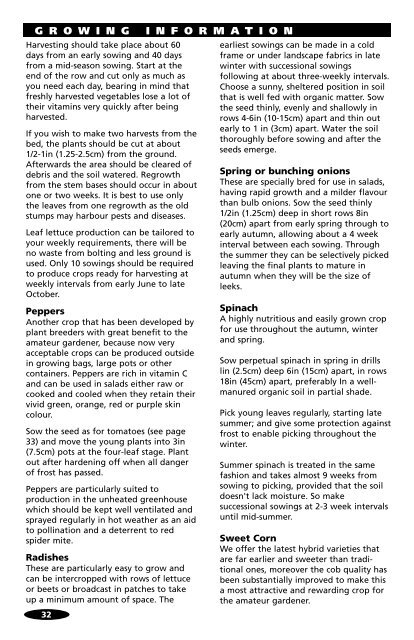Seed Guide 2007 pgs 01/41 - McKenzie Seeds
Seed Guide 2007 pgs 01/41 - McKenzie Seeds
Seed Guide 2007 pgs 01/41 - McKenzie Seeds
Create successful ePaper yourself
Turn your PDF publications into a flip-book with our unique Google optimized e-Paper software.
G R O W I N G I N F O R M A T I O N<br />
Harvesting should take place about 60<br />
days from an early sowing and 40 days<br />
from a mid-season sowing. Start at the<br />
end of the row and cut only as much as<br />
you need each day, bearing in mind that<br />
freshly harvested vegetables lose a lot of<br />
their vitamins very quickly after being<br />
harvested.<br />
If you wish to make two harvests from the<br />
bed, the plants should be cut at about<br />
1/2-1in (1.25-2.5cm) from the ground.<br />
Afterwards the area should be cleared of<br />
debris and the soil watered. Regrowth<br />
from the stem bases should occur in about<br />
one or two weeks. It is best to use only<br />
the leaves from one regrowth as the old<br />
stumps may harbour pests and diseases.<br />
Leaf lettuce production can be tailored to<br />
your weekly requirements, there will be<br />
no waste from bolting and less ground is<br />
used. Only 10 sowings should be required<br />
to produce crops ready for harvesting at<br />
weekly intervals from early June to late<br />
October.<br />
Peppers<br />
Another crop that has been developed by<br />
plant breeders with great benefit to the<br />
amateur gardener, because now very<br />
acceptable crops can be produced outside<br />
in growing bags, large pots or other<br />
containers. Peppers are rich in vitamin C<br />
and can be used in salads either raw or<br />
cooked and cooled when they retain their<br />
vivid green, orange, red or purple skin<br />
colour.<br />
Sow the seed as for tomatoes (see page<br />
33) and move the young plants into 3in<br />
(7.5cm) pots at the four-leaf stage. Plant<br />
out after hardening off when all danger<br />
of frost has passed.<br />
Peppers are particularly suited to<br />
production in the unheated greenhouse<br />
which should be kept well ventilated and<br />
sprayed regularly in hot weather as an aid<br />
to pollination and a deterrent to red<br />
spider mite.<br />
Radishes<br />
These are particularly easy to grow and<br />
can be intercropped with rows of lettuce<br />
or beets or broadcast in patches to take<br />
up a minimum amount of space. The<br />
32<br />
earliest sowings can be made in a cold<br />
frame or under landscape fabrics in late<br />
winter with successional sowings<br />
following at about three-weekly intervals.<br />
Choose a sunny, sheltered position in soil<br />
that is well fed with organic matter. Sow<br />
the seed thinly, evenly and shallowly in<br />
rows 4-6in (10-15cm) apart and thin out<br />
early to 1 in (3cm) apart. Water the soil<br />
thoroughly before sowing and after the<br />
seeds emerge.<br />
Spring or bunching onions<br />
These are specially bred for use in salads,<br />
having rapid growth and a milder flavour<br />
than bulb onions. Sow the seed thinly<br />
1/2in (1.25cm) deep in short rows 8in<br />
(20cm) apart from early spring through to<br />
early autumn, allowing about a 4 week<br />
interval between each sowing. Through<br />
the summer they can be selectively picked<br />
leaving the final plants to mature in<br />
autumn when they will be the size of<br />
leeks.<br />
Spinach<br />
A highly nutritious and easily grown crop<br />
for use throughout the autumn, winter<br />
and spring.<br />
Sow perpetual spinach in spring in drills<br />
lin (2.5cm) deep 6in (15cm) apart, in rows<br />
18in (45cm) apart, preferably In a wellmanured<br />
organic soil in partial shade.<br />
Pick young leaves regularly, starting late<br />
summer; and give some protection against<br />
frost to enable picking throughout the<br />
winter.<br />
Summer spinach is treated in the same<br />
fashion and takes almost 9 weeks from<br />
sowing to picking, provided that the soil<br />
doesn't lack moisture. So make<br />
successional sowings at 2-3 week intervals<br />
until mid-summer.<br />
Sweet Corn<br />
We offer the latest hybrid varieties that<br />
are far earlier and sweeter than traditional<br />
ones, moreover the cob quality has<br />
been substantially improved to make this<br />
a most attractive and rewarding crop for<br />
the amateur gardener.


